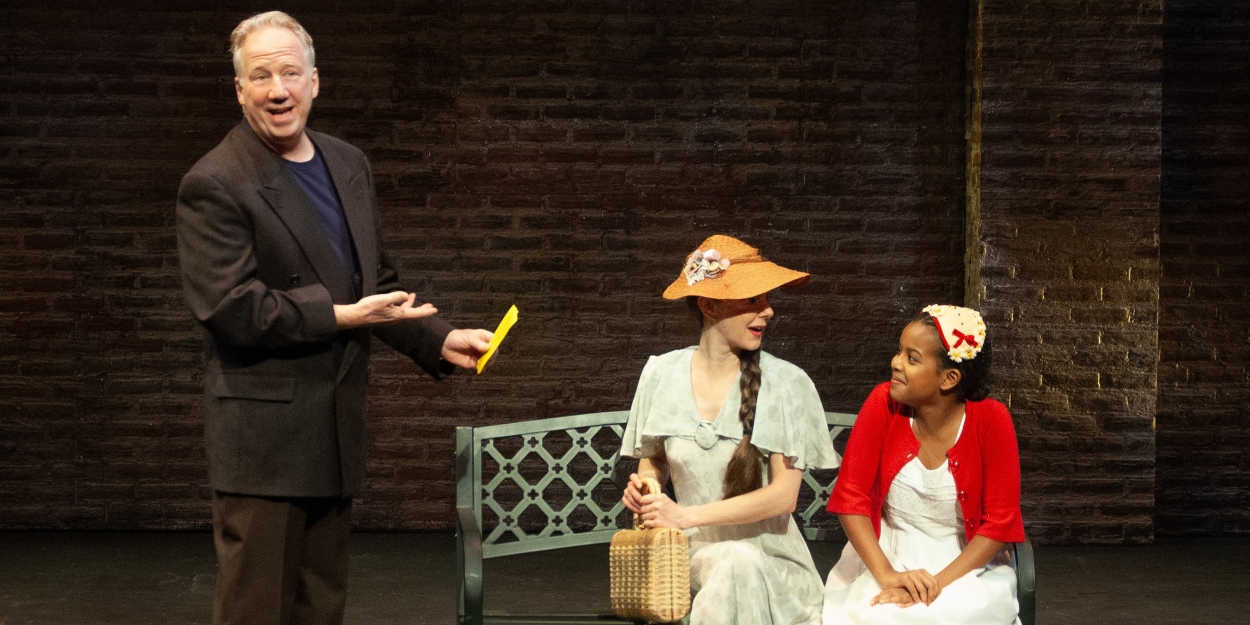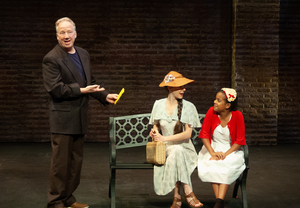Review: SAFE HOME at Shadowland Stages Is Based on Short Stories by Tom Hanks
Timothy Busfield shines in three tales tied together through time travel


Photo: Jeff Knapp
Interior. Theater. Intermission.
MAN
Are you following it?
WOMAN
I'm working on it, but it's not immediately apparent.
That real-life dialogue overheard from the couple seated behind me as soon as Act I ended pithily sums up the staging of the Tom Hanks-branded play Safe Home, on stage through Sunday, Aug. 7, at the sleekly-appointed Shadowland Stages in Ellenville (N.Y.).
That's not to glibly dismiss all the sweat equity and talent invested in this, or any, stage play that bears the professional imprimatur of Actors' Equity Association (AEA).
First, let's acknowledge the elephantine celebrity in the room. If public embrace were measured in dollars, Tom Hanks would be a trillionaire. It's as if the sobriquet "Beloved Actor" is bred into his birth name. And why not. I'm a fan. Who isn't? Combine versatility, consistency, longevity, popularity, credibility, humility and good guyness, and there you have Mr. Tom Hanks.
Long Book of Short Stories
Several years ago, a 400-page collection of 17 short stories penned by TH (does anybody call him that?) was published under the title Uncommon Type. Marquee names market themselves, and the book predictably landed on the bestseller lists.
The title Uncommon Type alludes both to the character studies Hanks the author favors - with skillful, if mixed, results - and to his hobby of collecting (and using) those relics of ingenuity called typewriters, which show up in every one of the stories. Hanks has an abiding fascination with yesteryear - focused on the 20th Century, which serves as the throughline of Safe Home.
As I was told by Shadowland Artistic Director Brendan Burke, theatricalizing Uncommon Type was not Hanks's idea. Rather, he was contacted by playwright-director James Glossman, who has made something of a specialty of reconstructing prose into plays.
Hanks was intrigued enough with the prospect of seeing his creations on page come to life on stage that he consented to collaborate with Glossman. The result is Safe Home, directed by Glassman, who co-wrote it with Hanks.
With 17 stories to choose from, Glossman and Hanks decided to focus on three.
Blasts from the Past
The play opens with tongue-in-cheek musings on time travel, based on Hanks short story "The Past Is Important to Us," which also serves as the play's interstitial framing device that carries us through the other two stories dramatized in the show.
"The Past Is Important to Us" is anchored by one Bert Allenberry, played by the other notable name attached to this high-profile Shadowlands project -- veteran TV and movie actor Timothy Busfield (whom I had the great pleasure of chatting with, via Zoom. Like Hanks, the guy we got to know on hit TV series thirtysomething and from cult sports classic Field of Dreams is as down-to-earth and affable as he is accomplished at his craft; in his profession that's an uncommon type, you might say).
Excellent and Versatile Cast
Starting with Busfield, whose intuitively natural acting is a lesson in less is more for any actor, the entire seven-person cast is uniformly excellent.
Busfield is Bert throughout, but the other six cast members each essay from three to five roles, employing an array of accents, with the most characters played by the youngest actor, 13-year-old Leyu Girma, who is a dynamo, though at times her expressive energy betrays her intellegibility.
Nikkole Salter does yeoman work as narrator, mother and refugee. Especially versatile in various roles -- including war veteran, baseball fan, and Greek diner owner -- is James Riordan. Rounding out the players with equal aplomb are Eilis Cahill, Paul Murphy and Angeline Rose Troy. They form a fine ensemble that gamely mines the uneven material and dramatic structure as best they can. With the exception of Girma and Troy, all are AEA members.
Busfield's Allenberry is an inventor who's made billions, and lives the high life, yet nurses a nagging impulse that his safe home may exist not in the present, but in the past. In search of something that seems as elusive to him as to us, he sets out to discover when and where that distant new home may exist.
World's Fair or Bust
As a client of Chronometric Adventures, which peddles time travel vacations, Bert's various jaunts -- pictured symbolically through stock film and stills on a looming jumbo screen -- take him to the 1939 New York World's Fair in "The Past Is Important to Us"; to Ulster County (N.Y.) in the second adapted story, "Christmas 1953," complete with a jarring side trip to a foxhole full of f-bombs; and, in the third story of the triptych ("Go See Costas"), to a Greek diner in 1949 lower Manhattan.
Contrasting with the austere, all-purpose set -- dotted with a smattering of furniture -- are two standout set pieces: the evocatively designed 1940s Greek diner and the middle-class, Norman Rockwellesque living room in "Christmas 1953." Scenic design is by Christopher Swader and Justin Swader.
As we tag along with Bert, we espy Babe Ruth hitting a home run in 1924, we visit Nashville's Grand Old Opry in 1961, we witness the public's first brush, in 1939, with televised images, and we pop in on the 1964 World's Fair (I remember it well). OK, all that travelogue stuff is cool as drive-by diversions, but to what purpose?
No Cohere There
As with the woman I eavesdropped on at the top of this review, at times an audience member can't be faulted for wondering, "Who's on first?" There are things that happen on stage that we observe and think "That's interessting," but when it comes to continuity, there is no cohere there.
On the whole, Safe Home's source material Uncommon Type was received by reviewers respectfully and, in some cases, warmly and admiringly, with the critical consensus that the 17 stories add up to aggressively common fare, which is to say the opposite of edgy or daring. To echo its theatrical spawn, the collection's byword is "safe."
That might be okay on its own terms, resting on the printed page. But being safe is virtually anathema to theater.
Theater exists to probe the unknown that holds life's mysteries, such as they are, out in the world and inside of us.
Theater yearns to be populated with characters and situations that are animated by high stakes. The higher the stakes, the more compelling the dramatic payoff for the theater-goer.
A theater veteran (as a playwright and artistic director) friend of mine who saw the show suggested that short stories such as these might play better as discrete one-acts, presented back-to-back but without a connective device like time travel.
In the script's effort to offset loose ends that recur every time Bert time travels to the 1939 World's Fair to woo a woman he pines for, there is a sleight-of-hand resolution at the final curtain. Alas, the lack of clarity that informs the preceding action devalues the payoff. What we witness at the end - projected on the giant screen effectively employed throughout the production - is momentarily amusing, as audience titters telegraphed, but not emotionally moving.
Part of the inherent challenge for Safe Home, for its cast, and for its patrons is that the stakes are, at best, middling, and never truly high. The characters tend to exist in their own private worlds, deprived of the motivation, introspection, and connection to other characters that are the lingua franca of dramaturgy.
What Does He Want?
Timothy Busfield acknowledged as much in our conversation. Asked how he prepared for the role of Bert Allenberry, the actor told me, "I faced the constant difficulty of wondering what does he want. I'm not sure we have mastered that yet. The actor has to figure out what we're connecting to and the audience has to figure it out, and we're still there."
In that sense, Busfield, along with Brendan Burke, approaches Safe Home, which I attended on its penultimate weekend, as a work in progress. Burke allowed as how "this is one step in the play's evolution, and adjustments will be made."
While neither Busfield nor Burke uttered the word "workshop" to describe this production, some well-traveled theater folk, namely my aforementioned friend, might see it that way, except for the fact that it's selling $40 tickets to the public, which is responding to the Hanks-Busfield star billing by filling the 179-seat venue to near-capacity for its four-weekend, 16-performance run that ends Sunday, Aug. 7. (As of Thursday afternoon, Aug. 4, the website showed only 20 seats unclaimed, for the 8 p.m. Friday, Aug. 5 performance.)
Make no mistake. Kudos are due Burke, Glossman and Shadlowland's collective braintrust for scoring a monetizable Hollywood connection, which I suspect any theater of its scale, given the chance, would hasten to entertain. That's a no-brainer.
More challenging, for any play, is keeping an audience entertained for two hours. If it moves on to further development, Safe Home hopefully will find ways to create a more holistic entertainment for its audience that better befits the sterling reputation of its creator.
____________________________________________________________________________
Additional Production Credits
Costume Design by Bettina Bierly. LIghting Design by Jeremy Johnson and Jack Wade. Sound Production Design by Jeff Knapp. Technical Director, Peter Johnson. Production Stage Manager, Nicole Caroselli. Assistant Stage Manager, Brett Owen. Assistant Costume Design, Miranda Graves. Director of Photography & Video Editor, Truman Hanks.
Reader Reviews

Videos

